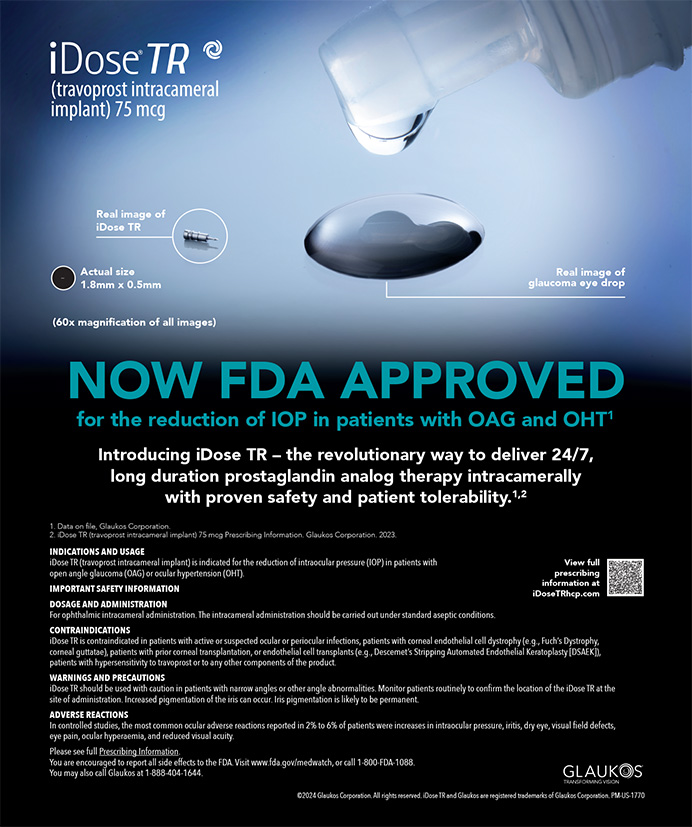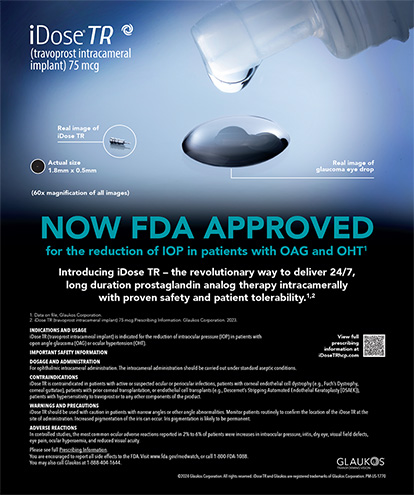The Allegretto, a flying-spot excimer laser from WaveLight Laser Technologies AG (Erlangen, Germany), features a 0.95-mm Gaussian beam, a mean fluence of approximately 200 mJ/cm2, a peak fluence of 400 mJ/cm2, and an active tracker with a response time of <8 ms. Six-month data show excellent gains in BCVA, and, compared with findings from cohort studies of other new excimer lasers, significantly greater improvements in UCVA and postoperative manifest refraction. Conventional LASIK with the Allegretto also appears to reduce, rather than increase, glare.
PILOT STUDY
In the initial, 150-eye pilot trial for myopia, approximately 10% of eyes had peripheral irregular astigmatism postoperatively. To eliminate this complication, the company increased the laser fluence and added a plume evacuator, as well as more energy sensors. Investigators incorporated these modifications into the study protocol and implemented them at all 11 participating study sites, one of which is mine.
Objective and Methodology
The aim of this trial was to evaluate the Allegretto for conventional LASIK performed on eyes with up to -14.0 D of myopia and up to 6.0 D of cylinder. All 11 sites followed standardized preoperative, intraoperative, and postoperative methodology (including long-term follow-up). This FDA investigational device exemption trial observed the usual guidance for excimer laser studies.
Outcome
The 6-month follow-up data for 739 eyes became available in June 2002. We analyzed the results in the following groups: all eyes, spheres, and spherocylinders. The manifest refraction for each group was well above the protocol targets; 86.7% of eyes were within 0.50 D of plano at 6 months. In addition, 60.9% of eyes achieved a UCVA of 20/16 or better (Figure 1). Only 0.4% of eyes lost two or more lines of BCVA (FDA target is <5%), and 70.3% gained one, two, or more lines of vision.
At a similar follow-up point in other excimer studies, the largest percentage of eyes typically consists of those with no demonstrable change in BCVA. By contrast, this study's largest group in terms of acuity gains/losses was that of eyes gaining one or more lines of BCVA. Only 37.1% of eyes showed no change, whereas 13.5% gained two or more lines of BCVA.
Investigators asked patients to rate glare pre- and postoperatively on an unnumbered scale from “none” to “severe.” Afterward, the ratings were quantified into a 10-point scale that researchers superimposed over the patients' assessments. Intriguingly, most patients experienced a statistically significant (P<.001) overall reduction in glare, from 4.1 preoperatively to 3.2 at the 6-month follow-up visit (Figure 2). Investigators found that an increase in glare was more likely to occur with higher corrections and residual refractive error, but this increase did not correlate with mesopic pupil size or with pre- or postoperative K readings.
Researchers performed an “apples-to-apples” comparison of this trial's results with other lasers', as published in the Summaries of Safety and Effectiveness from their investigational device exemption studies. Investigators used the same or similar comparison ranges (0 to -7.0 D, if available), adjusted for the number of eyes, and noted any technology-related differences (eg, the absence of a tracker). They found that all of the lasers produced similarly favorable results with respect to the number of eyes losing two or more lines of BCVA. As regards all other comparisons, however, they determined that the Allegretto produced significantly better outcomes (P<.001) (Figures 3 and 4).
CLINICAL IMPLICATIONS
The trial's 6-month data suggest that the Allegretto produces excellent visual outcomes, while causing few reported postoperative complaints (specifically, symptoms of glare). As mentioned, subjective patient data from the trial show that, on average, patients actually experience a decrease in glare after LASIK with this laser.
This finding may be attributed to the laser's ablation profiles, which WaveLight developed based on data from early company research using wavefront-guided treatments. WaveLight investigators' evaluation of pre- and postoperative aberrometery suggested that standard myopic ablations resulted in significantly increased spherical aberration. The amount of aberration within the 6.5-mm pupillary area was a function of treatment amount and preoperative asphericity.
The company modified the contour of the ablation profiles when designing its laser in order to decrease the amount of spherical aberration induced and to achieve a higher number of prolate corneas postoperatively. The result has been that, in an eye with average asphericity, LASIK treatment with the Allegretto of up to 6.0 D has caused little spherical aberration. There is not enough corneal tissue to avoid inducing spherical aberration with treatments of greater than 6.0 D, but company investigators have found that the amount is still less with this type of ablation profile versus the standard.
Karl G. Stonecipher, MD, is Director of the Southeastern Laser and Refractive Center in Greensboro, North Carolina. Dr. Stonecipher holds no financial interest in the product mentioned herein. He may be reached at (336) 282-5000; stonenc@aol.com.

